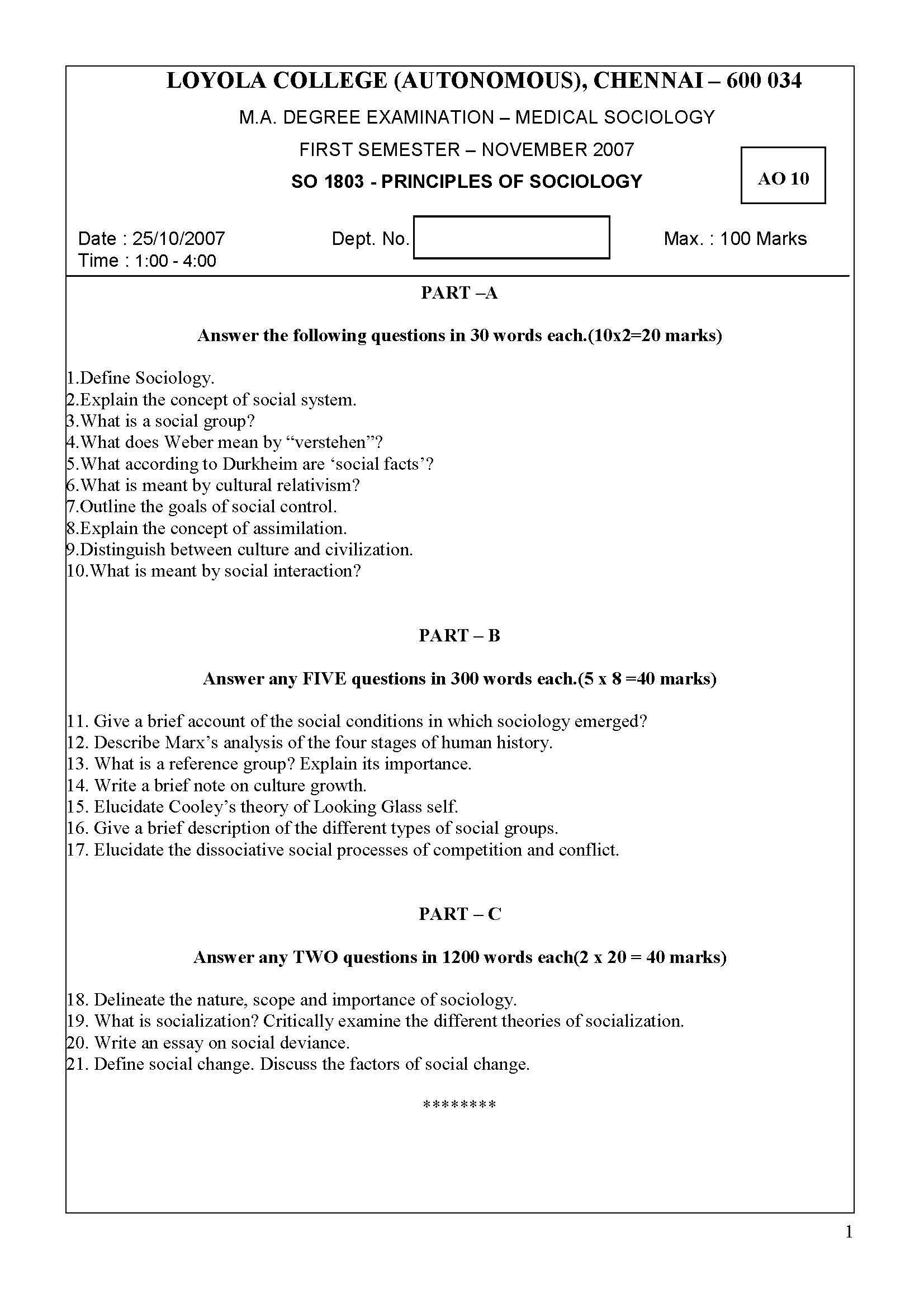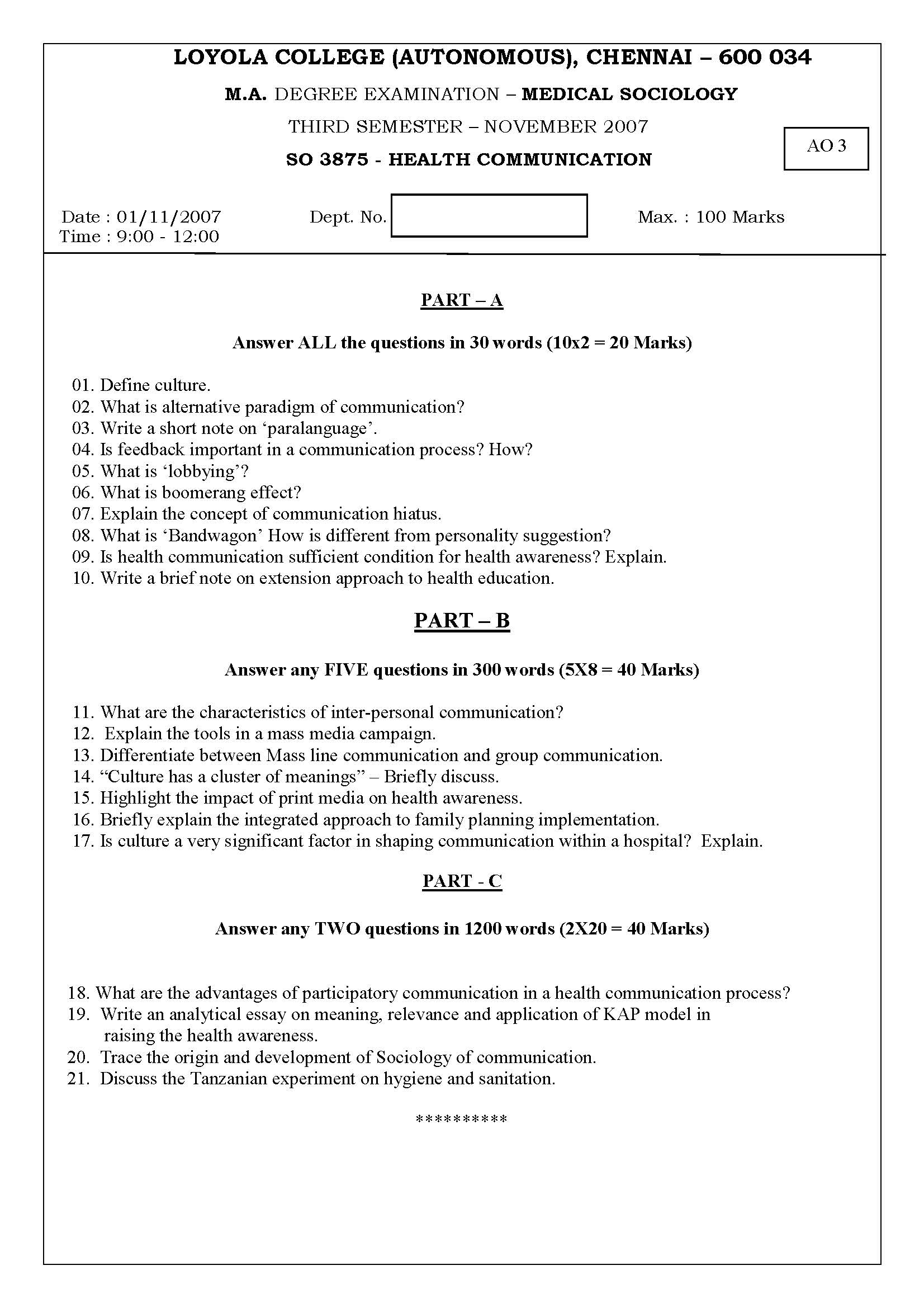Loyola College Question Paper 2007
Loyola College M.Sc. Chemistry Nov 2006 Analytical Chemistry Question Paper PDF Download
LOYOLA COLLEGE (AUTONOMOUS), CHENNAI – 600 034
M.Sc. DEGREE EXAMINATION – CHEMISTRY
|
FIRST SEMESTER – NOV 2006
CH 1809 – ANALYTICAL CHEMISTRY
Date & Time : 02-11-2006/1.00-4.00 Dept. No. Max. : 100 Marks
PART – A
Answer ALL the questions (10 ´ 2 = 20 marks)
- A Chemical balance is used to weigh 2.0000g of FAS. Find out the maximum relative uncertainty associated with the weight in ppt.
- Determine the pH of the mixture containing 20.00 mL of 0.0750 m CH3COOH and
30.00 mL of 0.0500 M NaOH. Ka of CH3COOH is 1 x 10-5. - How does GSC differ from GLC?
- Mention the factors which affect pm at the equivalence point.
- How does AAS differ from Flame photometry?
- Explain why MgCo3 is thermally less stable compared to Na2CO3.
- What is the difference between DTA and DSC.
- What will be the mass of ion deposited by a current of 9.65 A in 2 minutes passed in to a solution of ferric chloride(Fe : At . wt = 55.85)?
- How many faraday current is required to reduce one mole of MnO4 to mn2+.
- State Beer Lambert’s Law.
PART – B
Answer any EIGHT questions (8 ´ 5 = 40 marks)
- Apply ‘t’ test and ‘F’ test to check whether two sets of data differ significantly or not.
- Discuss the principle of GLC.
- Draw the titration curves for the following and interpret the result.
- 00 mL of 10-1M CH3 COOH vs 10-1M NaOH
- 00 mL of 10-2 M CH3 COOH vs 10-2 M NaOH
- Show that the fraction of completely ionized form of EDTA depends on pH.
- A solution containing 8.75 ppm KmnO4 has a transmittance of 75% in a 1 cm cell at
520 nm. Calculate the molar absorptivity of KmnO4. - The organic matter in a 0.3775 g sample of a mercuric ointment is decomposed with HNO3 . After dilution the Hg+2 is titrated with 21.30 mL of a 0.1140 M solution of NH4SCN. Calculate the % of Hg (f.w = 200.59) in the ointment and express it scientifically Hg+2 + 2SCN⇌ Hg(SCN)2 .
- Cupric nitrate decomposes as follows.
Cu (NO3)2 .2½ H2O Cu (NO3)2 + 2½ H2O (100-150oC)
Cu(NO3)2 CuO + NO2 + 1½ O2 (200 – 280oC)
Calculate the residual mass if 100 mg of hydrated cupric nitrate in heated upto 250oC.
- Calcium oxalate monohydrate undergoes three types of weight loss, whereas magnesium oxalate shows only two types of weight loss. Explain.
- How will you estimate copper electro gravimetrically?
- Calculate the emf w.r.f SCE when 1 ml of 0.25 m K2Cr2O7 is added to 20 ml of 0.05 m Fe2+ in 0.1 m HCl.
- Explain the coulometric titration of I– Vs S2O3 2–
- Explain the quantitative application of polorography.
PART – C
Answer any FOUR questions (4 ´ 10 = 40 marks)
- Potassium can be determined by flame emission spectrometry using a lithium internal standard. The following data were obtained for standard solutions of KCl and an unknown containing a constant known amount of LiCl as internal standard. All the intensities were corrected for background by subtracting the intensity of a blank.
| Conc K, ppm | Intensity of Emission |
| 1.0 | 10.0 |
| 2.0 | 15.3 |
| 5.0 | 34.7 |
| 7.5 | 65.2 |
| 10.0 | 95.8 |
| Unknown | 47.3 |
Apply the method of least squares to obtain the equation for the best straight line through these points. Determine the standard deviation of the slope and the result, if the unknown intensity corresponds to the mean of 4 measurements. Also find out the concentration of K in the unknown.
- Draw the flow sheet diagram of HPLC and explain the function of the components.
- a) A 0.4085 g sample containing pb, mg and Zn was dissolved and treated with cyanide to complex and mask the zinc;
Zn+2 + 4 CN– [Zn(CN)4] 2–.
Titration of the lead and magnesium required 42.20 ML of 0.02065 M EDTA. The lead was next masked with BAL (2,3 dimercaptophepanol), and the released EDTA was titrated with 19.35 mL of 0.007650 m Mg+2 solution. Finally HCHO was introduced to demask the Zinc;
[Zn(CN)4] 2– + 4HCHO + 4H2O Zn+2 + 2OH– + 4 CNCH2OH.
The zinc was then titrated with 28.60 mL of 0.02065 EDTA. Calculate the percentages of the three metals in the sample. (7)
- b) Explain the principle of Flame Photometry. (3)
- a) How will you prove the liberation of Carbon monoxide by thermal analysis.
- b) 2.92 mg of a sample of mgSo4.7H2O losses 0.62 mg at 105o C due to the following
reaction
MgSo4.7 H2O MgSO4.H2O + 6H2O.
calculate the % purity of the sample.
- Explain the potentimetric titration of acidified Fe2+ against standard MnO4–
[SRP: Fe3+, Fe2+ = 0.77 MnO4–, Mn2+, H+ = 1.51 V]
Write the electrode reactions before and after the equivalence point and draw the titration curve.
- a) Explain the instrumentation of a classical fluorimeter.
- b) Explain the applications of Cyclic voltametry.
Loyola College M.Sc. Chemistry April 2007 Thermodynamics & Statistical Mechanics Question Paper PDF Download
LOYOLA COLLEGE (AUTONOMOUS), CHENNAI – 600 034
M.Sc. DEGREE EXAMINATION – CHEMISTRY
|
SECOND SEMESTER – APRIL 2007
CH 2810 – THERMODYNAMICS AND STATISTICAL MECHANICS
Date & Time: 21/04/2007 / 1:00 – 4:00 Dept. No. Max. : 100 Marks
PART A
Answer ALL the questions. (10 x 2 = 20 Marks)
- Calculate the fugacity of H2 at 1000C and 300 atm. The density of H2 at the above conditions is 16.79 g dm-3.
- Show that mi (Chemical potential) = (dH/dni)P,S,,nj
- A 4.84 molal aqueous solution of a non-volatile solute has a vapour pressure of 18.5 mm of
Hg at 250C. At the same temperature the vapour pressure of the pure water is 23.6 mm of Hg. Assuming that the water vapour behaves ideally, calculate the activity and the activity coefficient of water (g x) in the given solution.
- The equilibrium constant for the reaction, C(s)+CO2(g) Û2CO(g) is 4.28 x 10-3 atm at 1200 K. If the partial pressure of CO2 is 1.2 atm, calculate partial pressure of CO.
- What is Onsager theory?
- State Sterling’s approximation and hence evaluate ln N!, when N = 1030
- What is the significance of partition function?
- Using equipartition principle, evaluate CV for PH3(g) if R=2 cal K-1 mol-1.
- Calculate the number of ways of distributing three particles among four energy levels if the particles obey Pauli’s exclusion principle.
- What is thermionic emission?
PART – B
Answer ANY EIGHT questions (8 x 5 = 40 Marks)
- Explain the significances of the Ellingham Diagram.
- Draw and explain the phase diagram of a three component system consisting of two solids (B and C) and water with the formation of a salt hydrate (B.nH2O)
- Calculate the fugacity of H2 at 200 atm and 300 K if the fugacity at 25 atm and 300 K is 25.2 atm. The van der Waals constants are a=0.245 l2 atm mol-2 and b = 2.67×10-2 l mol-1
- The dissociation of N2O4(g) takes place according to the equation, N2O4(g) Û 2NO2(g). At 300 K, 0.92 g of N2O4 contained in a flask of 1.64 litre capacity was found to have a total pressure of 137 mm of Hg. (i) Calculate the degree of dissociation at this temperature and pressure (ii) Calculate the value of KP at the above conditions.
- Explain the determination of activity coefficient of using solubility product.
- Write a note on entropy production and entropy flow in the open system using the principles of non-equilibrium thermodynamics.
- Explain how partition functions are separated?
- Two of the energy levels of a molecule are e1 = 6 x 10-21 J and e2 = 8.4 x 10-21 J, the corresponding degeneracies being g1 = 3, g2=5. What is the ratio of the distribution numbers in an assembly of molecules at 3000 K?
- The vibrational frequency of Cl2 molecule is 1.66 x 1013 s-1. Calculate Qvib and the vibrational partition function at 300 K
- Compare the three statistical distributions.
- Calculate the equilibrium constant for the reaction S2(g) à 2S at 2000 K. The dissociation energy is 429.7 kJ mol-1 and the free energy function at 2000 K for S(g) and S2(g) are – 191.4 and –265.5 J K-1 mol-1.
- Show that the rotational energy of a diatomic molecule is equal to RT.
PART – C
Answer ANY FOUR questions (4 x 10 = 40 Marks)
- a) How will you determine the activity coefficient of the solvent knowing the activity of the solute? (5)
- b) Consider a hypothetical solute in 1 kg of water. The volume V(ml) at 250C and 1 atm is represented as, V = 1000.38 + 20.563 m2 + 2.024 m22 – 0.24 m23 . Derive the expression for the partial molal volume of the solute and calculate its value at 1 molal solution. (5)
- a) Explain Lever Rule (3)
- b) Using the principle of microscopic reversibility, prove the Onsager’s reciprocal relation. (7)
- For the reaction 2HCl(g)+1/2 O2(g) ó H2O(g) + Cl2(g), DH0298 K = -57.2 kJ mol-1,
DG0298 K = -38.07 kJ mol-1. Compute the value of KP at 500 K. CP (HCl) (J K-1 mol-1) =
28.16 + 1.8 x 10-3 T, CP (O2) (J K-1 mol-1) = 25.48 + 13.6 x 10-3 T, CP (H2O) (J K-1 mol-1) =
30.21 + 9.92 x 10-3 T and CP (Cl2) (J K-1 mol-1) = 31.71 + 10.12 x 10-3 T
- a) Write Sackur-Tetrode equation and explain its significance (5)
- b) Show that the translational energy is equal to 3/2 RT. (5)
- Explain the salient features of Debye’s theory of heat capacity of solids. Compare it with Einstein’s theory.
- Explain an two of the following:
- a) Statistical formulation of ARRT
- Bose-Einstein distribution law
- Residual entropy

















